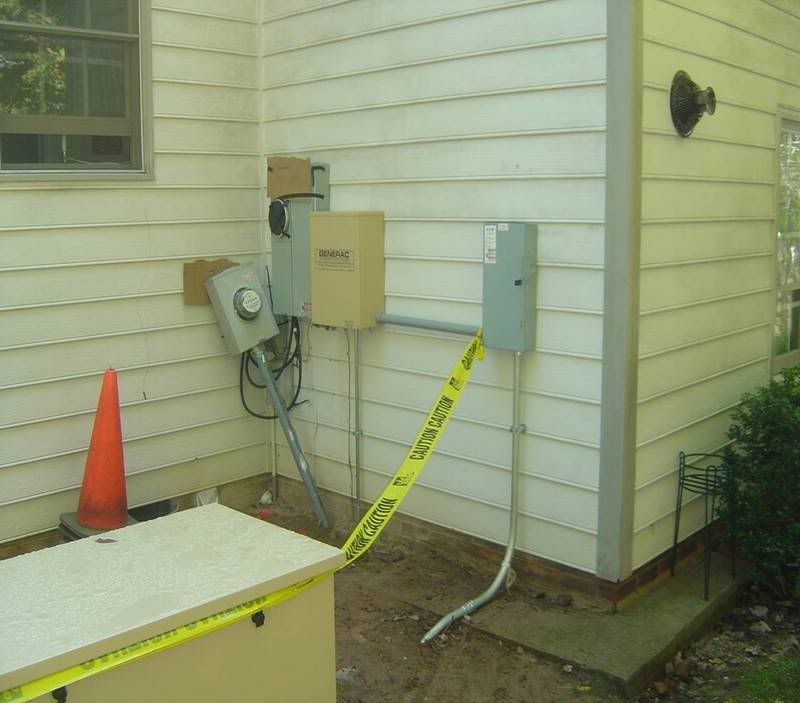M. D.
Senior Member
Submitter: Mark R. Hilbert, State of New Hampshire
Recommendation: Revise text to read:
702.11 Outdoor Generator Sets. Where an outdoor housed generator set is
equipped with a readily accessible disconnecting means located within sight of
the building or structure supplied, an additional disconnecting means shall not
be required where ungrounded conductors serve or pass through the building or
structure.
Add a new fine print note to read as follows:
FPN: Section 225.36 provides additional requirements for the suitability of
the disconnecting means.
Substantiation: The recommendation for this fine print note is an attempt
to identify the requirements of 225.36 for the building disconnecting means,
which in this case will be located at the generator, to be ?suitable for use
as service equipment.? Additionally, this FPN will help identify an often
overlooked requirement, clarify that even though it is remote to the building,
the disconnecting means must be suitable for use as service equipment and that
the requirement in 225.36 is not amended by 702.11.
Panel Meeting Action: Reject
Panel Statement: See the panel action statement on Proposal 13-131.
Number Eligible to Vote: 14
Ballot Results: Affirmative: 13
Ballot Not Returned: 1 Gustafson, R.
this is the panel statement refered to
(6) Outdoor Generator Sets. Where an outdoor housed generator set is
equipped with a readily accessible disconnecting means located within sight of
the building or structure supplied, an additional disconnecting means shall not
be required where ungrounded conductors serve or pass through the building or
structure.
Add a new fine print note to read as follows:
FPN: Section 225.36 provides additional requirements for the suitability of
the disconnecting means.
Substantiation: The recommendation for this fine print note is an attempt to
identify the requirements of 225.36 for the building disconnecting means,
which in this case will be located at the generator, to be ?suitable for use as
service equipment.? Additionally, this FPN will help identify an often
overlooked requirement, clarify that even though it is remote to the building,
the disconnecting means must be suitable for use as service equipment and that
the requirement in 225.36 is not amended by 700.12(B)(6).
Panel Meeting Action: Reject
Panel Statement: The disconnect required in 700.12(B)(6) is not intended to
be a service disconnect.
____________________________________________________________
Recommendation: Revise text to read:
702.11 Outdoor Generator Sets. Where an outdoor housed generator set is
equipped with a readily accessible disconnecting means located within sight of
the building or structure supplied, an additional disconnecting means shall not
be required where ungrounded conductors serve or pass through the building or
structure.
Add a new fine print note to read as follows:
FPN: Section 225.36 provides additional requirements for the suitability of
the disconnecting means.
Substantiation: The recommendation for this fine print note is an attempt
to identify the requirements of 225.36 for the building disconnecting means,
which in this case will be located at the generator, to be ?suitable for use
as service equipment.? Additionally, this FPN will help identify an often
overlooked requirement, clarify that even though it is remote to the building,
the disconnecting means must be suitable for use as service equipment and that
the requirement in 225.36 is not amended by 702.11.
Panel Meeting Action: Reject
Panel Statement: See the panel action statement on Proposal 13-131.
Number Eligible to Vote: 14
Ballot Results: Affirmative: 13
Ballot Not Returned: 1 Gustafson, R.
this is the panel statement refered to
(6) Outdoor Generator Sets. Where an outdoor housed generator set is
equipped with a readily accessible disconnecting means located within sight of
the building or structure supplied, an additional disconnecting means shall not
be required where ungrounded conductors serve or pass through the building or
structure.
Add a new fine print note to read as follows:
FPN: Section 225.36 provides additional requirements for the suitability of
the disconnecting means.
Substantiation: The recommendation for this fine print note is an attempt to
identify the requirements of 225.36 for the building disconnecting means,
which in this case will be located at the generator, to be ?suitable for use as
service equipment.? Additionally, this FPN will help identify an often
overlooked requirement, clarify that even though it is remote to the building,
the disconnecting means must be suitable for use as service equipment and that
the requirement in 225.36 is not amended by 700.12(B)(6).
Panel Meeting Action: Reject
Panel Statement: The disconnect required in 700.12(B)(6) is not intended to
be a service disconnect.
____________________________________________________________


